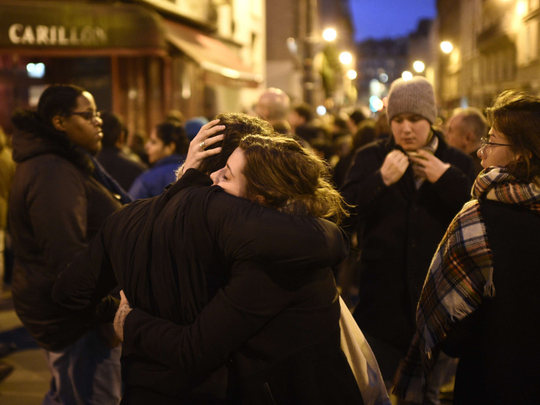
Paris remains eerily quiet. Straight after the terrorist attacks, on November 13, the tourists disappeared. Now, in grey January, the world’s formerly most visited city still feels empty. In the silence, Parisians can gauge where the attacks have left us.
My office is in the eastern 11th arrondissement, focal point of both sets of 2015 attacks. The little local post office now has a full-time guard to check customers’ bags. A few doors down, the Belle Equipe cafe — where 19 people were murdered in November — is boarded up, to reopen God knows when. My favourite local restaurant is offering an unchanging daily menu all week, presumably because with almost no customers there’s little point buying food every day. But you can get a table any time, and eating is still much of the point of Paris, so you sit there instinctively calculating where you’d run if gunmen walked in.
Perversely, the horrors have helped give Paris’s east side an identity. The historically poorer east, even after gentrification, was always the neglected Paris. It ranked below les beaux quartiers (“the beautiful neighbourhoods” in the west and on the Left Bank), just as Brooklyn ranked below Manhattan. The local Place de la Republique, for decades a big roundabout with a dirty old statue of Marianne, symbol of the republic, was Paris’s drabbest square.
But last year’s attacks targeted the east’s nightlife, its partially Jewish heritage and its bohemian classes as represented by Charlie Hebdo magazine. The evening of the Charlie attacks last January, thousands of people filled Republique — which, by chance, had recently been redesigned. The crowd chanted, “Liberty of expression!” (only in Paris) and honoured the murdered cartoonists. Days later, western heads of government shuffled east together from REpublique down the unlovely Boulevard Voltaire, looking terrified.
Republique is now again a site of pilgrimage. In the evenings you see people lighting candles around the statue, scrawling the strangest messages, or singing John Lennon’s “Imagine”. The poet Jacques Prevert said of late 1940s Saint-Germain, “Perhaps it takes a war to launch a quartier.” Now terrorism has launched REpublique.
But eastern Paris is scared. Two days after the November attacks, the ringleader Abdelhamid Abaaoud boasted (according to a witness) that “there will be other [attacks]”. These “would do even worse in the neighbourhoods near the Jews”, including “diversions on transport and in the schools”. Perhaps this was just a terrorist pipe dream but it’s stressful if you have kids in local schools. Parents and the headmaster of our school are currently debating whether or not we need an armed policeman in front.
The new fear overlies the longstanding French morosite: national discontent with the country’s path (or lack of path). Over lunch recently, I listened to a high-status Parisian deliver the ritual rant about the government that ends with, “C’est n’importe quoi” (roughly, “It’s a mess”). I’ve been hearing this speech since moving to Paris in 2002 but, for the first time, I thought: “Yes, it really is that bad.”
I had previously believed French morositE was exaggerated. True, France was struggling, but so were all western nations after the crisis of 2008. Now, though, France is doing worse than others. Before, it could look at Italy and think, “There’s a country that really hasn’t adjusted to modernity.” But, lately, Italy has reformed its rigid labour market, cutting unemployment. So has Spain. France has done much less, so far at least.
The brainy people who run this country mostly know what needs changing. In the office of one senior government aide, I saw a whiteboard on which someone had written a sort of national mea culpa, in English: “If it moves, tax it. If it still moves, regulate it. If it doesn’t move, subsidise it.”
. . .
But French governments dare not reform. They presume (perhaps rightly) that most French voters think that the status quo is terrible but must never be changed. And so unemployment keeps rising, recently reaching a new record of 3.59 million. Now President Francois Hollande has come up with a brilliant scheme to cut joblessness: shift 500,000 unemployed people into training programmes.
Another brilliant Hollande scheme (soon backtracked from, like most Hollande schemes) was to strip convicted dual-national terrorists of French citizenship. This fantastically pointless gesture has already spawned weeks of furious debate. Meanwhile, the land of liberty lives under a state of emergency expected to continue (according to prime minister Manuel Valls) until Isis is defeated. Even George W Bush didn’t go that far after the attacks of 9/11.
Add on the damage from terror to race relations, plus the first fall in French life expectancy since 1969, and no wonder France’s far right is at a postwar high. Next year’s election may pit Hollande and former president Nicolas Sarkozy - two bad films we’ve already seen - against the far right’s Marine Le Pen, a horror movie that surely won’t get made.
For now we sit in cafEs, enjoying what is still the best daily life in human history, and hope that one day we will look back and think: and just at that moment of maximum bleakness, France turned itself around.
— Financial Times










